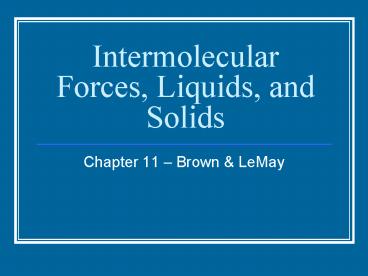Intermolecular Forces, Liquids, and Solids - PowerPoint PPT Presentation
1 / 27
Title:
Intermolecular Forces, Liquids, and Solids
Description:
Boiling point reflects strength of bonds in liquid ... Approximately 15% of covalent or ionic strength. Ion - dipole. When? Ionic solid polar liquid ... – PowerPoint PPT presentation
Number of Views:204
Avg rating:3.0/5.0
Title: Intermolecular Forces, Liquids, and Solids
1
Intermolecular Forces, Liquids, and Solids
- Chapter 11 Brown LeMay
2
Temperature Review
- Measure of kinetic energy
- What can you say about the KE of salt particles,
water molecules, and oxygen particles at room
temperature? - State determined by strength of forces that keep
particles together
3
Strength
- Compare energy needed for phase change vs.
decomposition in HCl(l) - Intermolecular (called weak) because they are
weaker than ionic or covalent - Boiling point reflects strength of bonds in
liquid - Melting point reflects strength of bonds in solids
4
Kinds of Intermolecular Forces
- Three major kinds dipole-dipole, London
dispersion, and hydrogen bonding - In solutions, ion-dipole
- All are electrostatic in nature
- Approximately 15 of covalent or ionic strength
5
Ion - dipole
- When?
- Ionic solid polar liquid
- Increases with increasing charge of ion or
polarity of solvent - Determines solubility
6
Dipole-Dipole forces
- Weaker than previous
- end of one attracts end of another
- If size is equal, more polar has stronger dipole
attractions. (NH3 vs H2O) - If polarity is the same but masses differ, than
smallest is stronger. (Able to orient better)
7
London Dispersion Forces
- All molecules have this
- Only attraction in nonpolar molecules
- How can Iodine be a solid?
- Temporary lopsided charge builds up from random
motion of electrons - 1930 - Increases with mass we say it has greater
polarizability - Straight molecule is more polarizable than a
curled up molecule why? - Halogen Family is a great essay
8
Hydrogen Bond
- Strongest of all weak forces
- Is caused when H is bonded to F, O, or N
- These are so electronegative that the H is a
naked nucleus or bare proton - Very attractive!
- Will bond to nearby electron pairs
9
Importance of Hydrogen Bonding
- Biological systems DNA, proteins
- Water chemistry (MP, BP, specific heat, surface
tension) - Density of ice
10
Density
- Most solids are more dense than liquid
- Water is less dense because of hydrogen bonding
- At 4C, water becomes less dense
- Important for life in winter
- Causes lake turnover
- Alum example
11
Practice
- Look at Flow Chart
12
Properties of Liquids
- Viscosity
- Slower than..
- Resistance of a liquid to flow
- Time it as it goes through a small tube with
gravity acting upon it. - Poise 1g/cm-s
- Trends same substance decreases with
increasing temperature - series (same structure) increases with
increasing mass
13
Surface Tension
- How many drops on a penny?
- Uneven forces at surface
- Acts like pond scum
- Definition energy needed to increase the
surface area of a liquid by a certain amount - Water is high why?
- Called cohesive force together
- Water moving up a stem adhesive force
- Capillary acion rise up a thin tube
- Meniscus!
14
Phase Changes
- Solid to Liquid is called Heat of Fusion ?Hfus
- For water, 6 kJ/mol
- Liquid to Gas is called Heat of Vaporization
- ?Hvap
- For water, 40.7 kJ/mol
- ?Hsub is sum of each
15
Heating Curve
- Try a problem
- Remember - flat during phase change, temperature
change when heating a single phase - Cooling is opposite
16
Supercooling
- Happens with some liquids - remove heat and it
doesnt freeze when it should - Very unstable
- May happen during hibernation
17
Critical Temperature
- Highest temperature at which a liquid can form
from a gas when pressure is applied. - Above this, the substance is called a
supercritical fluid. - Gas just becomes more compressed.
- Critical pressure - pressure at the critical
temperature
18
Vapor pressure
- Vapor pressure forms above any liquid if
container is closed why? - Equilibrium is reached
- This is vapor pressure
- Higher if forces holding liquid together are weak
- called a volatile (fleeing) liquid
19
Boiling Point
- Temperature at which the VP equals atmospheric
pressure - Normal BP - boiling point at 1 atm
- Everest? Autoclave?
20
Phase Diagram
- Handout
- Look at lines
- Look at slope of AB
- Freeze-drying - library book example
21
Water vs. CO2
22
Structure of Solids
- Amorphous (rubber, plastics) - large or mixtures
- no true structure - Crystalline - highly ordered structure
- Crystalline solids have true melting points
23
Unit Cell
- Repeating unit of a solid
- 7 types (6-sided parallelograms)
- Ni, Na, NaCl
- Array of points in the crystal lattice
24
3 cubic unit cells
25
Total Atoms for each unit cell
26
Packing
- Spheres naturally pack hexagonally
- Animation
27
Bonding
- Shown by x-ray diffraction
- Molecular - low MP
- If unit packs well, mp can be high
- Covalent Network Solid - very strong
- Many covalent bonds in 3-D
- Diamond, graphite, SiO2, SiC, BN
- Ionic - greater charge, greater MP
- Metallic solids - hexagonal close packed, mp
varies

